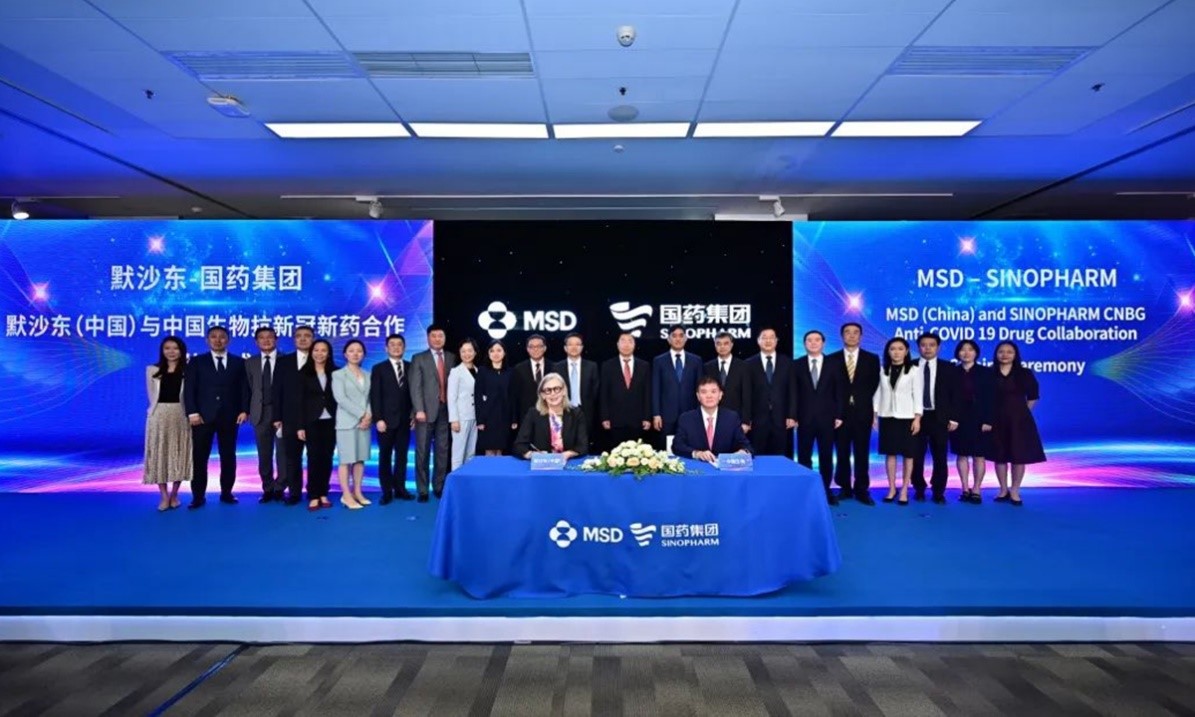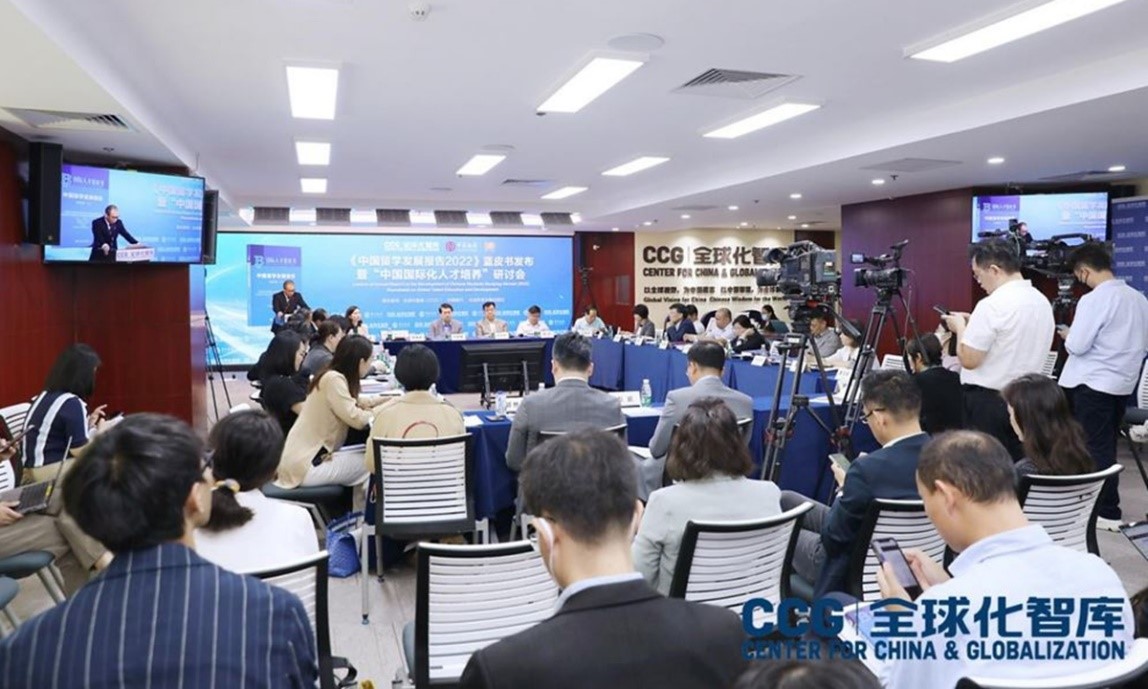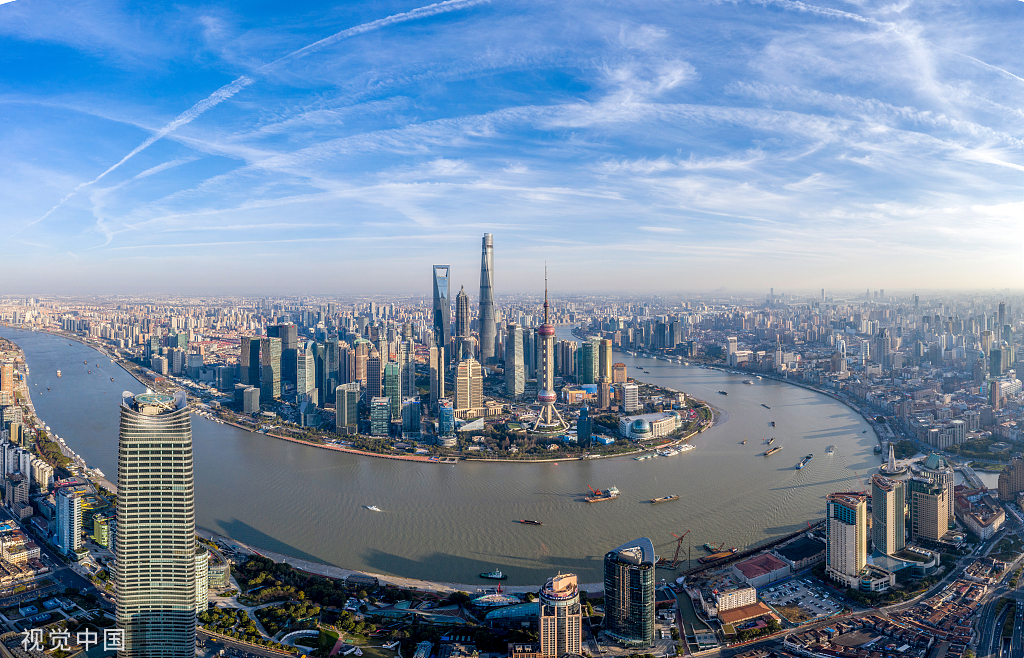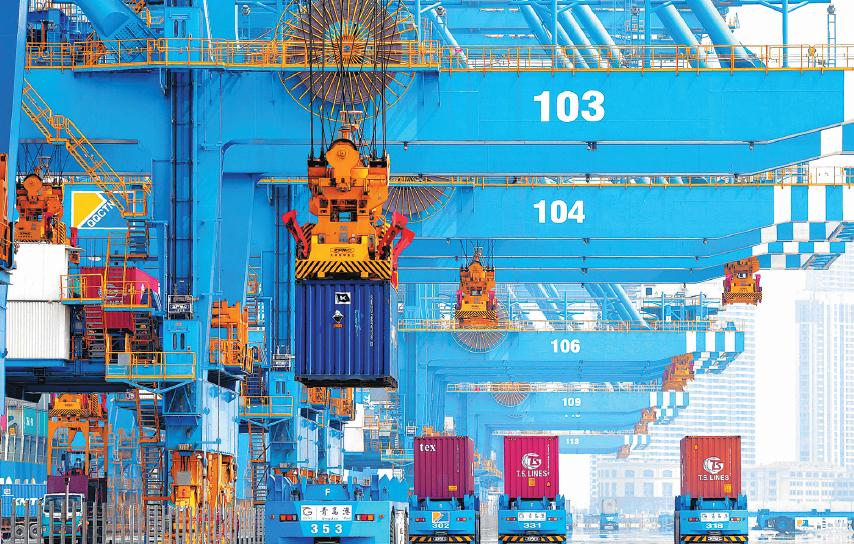1
Sinopharm, Merck sign deal on COVID drug, to negotiate technical transfer

China's large vaccine producer Sinopharm and US pharmaceutical giant Merck Sharp & Dohme (MSD) signed a cooperation framework agreement on Wednesday, under which Sinopharm would be a dealer and exclusive commission agent of MSD's antiviral COVID-19 medicine in China.
The two sides will also negotiate the feasibility of a technical transfer under the framework so that the drug Molnupiravir could be produced and provided in the Chinese mainland market, according to a statement Sinopharm sent to the Global Times on Wednesday.
Application materials for approval of the drug in the mainland have been submitted. Under the cooperation framework, Sinopharm would obtain dealership and exclusive import rights of Molnupiravir. Sinopharm would actively promote the localization of production and provision of the treatment after MSD transfers the techniques in order to help China to fight the pandemic, according to the statement.
Molnupiravir is one of the two most used oral COVID-19 treatments. The other is Pfizer's Paxlovid.
According to the statement, Molnupiravir has been approved or put into emergency use in more than 40 countries and regions including the US, EU, Australia, Japan and South Korea, as well as China's Hong Kong and Taiwan regions. As of the end of August, MSD had delivered 8.6 million courses of Molnupiravir to about 30 markets and treated more than 1.8 million patients.
Wu Hao, the chief of the Infectious Diseases Department of Beijing Youan Hospital, Capital University of Medical Sciences, said at the signing ceremony that Molnupiravir is an oral medication for mild and moderate COVID-19 cases in adults at risk of hospitalization and progression to severe illness. Previous studies showed that it can significantly reduce cases of hospitalization and death.
Analysis showed that the treatment can reduce hospitalization or death by 30 percent, and it eases symptoms like anosmia, fever and cough. The virus load can largely decrease on the third, fifth and tenth days after treatment, Wu noted.
A ferret-based animal experiment showed that patients with COVID-19 could become non-infectious within 24-36 hours after the onset of oral treatment, according to Wu.
Previous studies and real world data showed that Molnupiravir has antiviral activity against various SAR-CoV-2 variants including the dominant Omicron, Wu noted.
According to a study released in early August in the New England Journal of Medicine, some small-molecule antiviral drugs including Molnupiravir may have therapeutic value against the sublineages BA.2.12.1, BA.4, and BA.5 of SARS-CoV-2 Omicron variants.
Real world data in China's Hong Kong Special Administrative Region showed that Molnupiravir use was associated with a significantly lower risk - 47 percent lower - of disease progression than non-use and 45 percent lower than the risk of mortality connected to non-use, according Wu.
Another advantage of Molnupiravir compared with other oral antiviral treatments is that it does not trigger drug-drug interactions with existing medications. Thus, it is suitable for COVID-19 patients with renal or liver damage, as well as those of higher ages and all weights, Wu noted.
"We need more options for COVID-19 treatment in face of the rapidly mutating virus. Molnupiravir is the newest option for China to combat the pandemic," Wu said.
Sinopharm Chairman Liu Jingzhen said at the signing ceremony that cooperation with MSD is an active practice to treat COVID-19 and build a global community of health for all. Liu hoped that the two sides could exploit each other's advantages, enhance international cooperation, and provide Chinese patients as soon as possible with qualified, accessible and affordable drugs.
Rob Davis, chief executive officer and president of MSD, said in a statement that MSD is very happy to cooperate with Sinopharm to provide China with the treatment.
"It's our latest major effort to help the world combat the pandemic and promote the global usage of the treatment," read the statement.
Media Source: Global Times
2
Chinese students in US see first decline in 10 years: think tank

Chinese students may choose to study in European and Asian countries instead of the US or Australia in the future due to geopolitical factors, said a report released by a Chinese think tank on Wednesday, which also noted that the number of overseas Chinese students coming back to China after graduation will witness a continuous increase.
The annual report was published by the Center for China and Globalization (CCG), a Beijing-based think tank, with a theme on the development of Chinese students who study abroad, which analyzes the scale, study destinations and other aspects of recent graduates.
The report pointed out that while the US and Australia are still among the top five destinations for Chinese students, the number of Chinese students in both countries has decreased due to the worsening China-US relations as well as trade and geopolitical disputes between China and Australia.
According to the report, the number of Chinese students in the US in the 2020-2021 academic year saw the first decline in 10 years, falling 14.6 percent from 2019-2020. The number of Chinese students in Australia decreased for two years, with a drop of 11.9 percent in 2021 and 9.9 percent in 2020.
The report said that more Chinese students may switch to countries in Europe and Asia where the study environments and visa policies are friendlier. "While European countries like France and Germany continued to introduce policies to attract or make it more convenient for Chinese students to study in their countries, Asian countries like Japan, South Korea and Singapore also became more favorable for their geographical proximity, similar cultural attributes and relatively affordable tuition," read the report.
As overseas Chinese students prefer studying STEM (science, technology, engineering, and math) and commerce, the report warned that overseas students may face limitations in some sensitive key technology subjects in some of the Five Eyes countries.
The US Senate passed the Innovation and Competition Act in June 2021 to strengthen censorship of China-participating projects in artificial intelligence, semiconductors, quantum computing and so on. Five months later, Australia introduced the Blueprint for Critical Technologies to enhance protections for 63 key technologies.
Besides the possible restrictions on international students in sensitive areas, experts also pointed out countries like the US have seen fewer unofficial exchanges with China in recent years.
Zhou Mansheng, former deputy director of the Education Development Research Center at the Ministry of Education, noted at Wednesday's report conference that some exchange projects between US and Chinese scholars, which have lasted for a long time, were suspended in recent years, calling for the resumption and promotion of such exchanges and communication.
The report also highlighted that the "return rate," which refers to the percentage of Chinese students coming back to China after graduation, has largely increased. This is a result of China's rapid economic development and talent attraction policies, and it is also influenced by the complex international situation including changing of foreign countries' visa policies, it said.
According to the National Bureau of Statistics of China, the return rate in 2019 was 82.5 percent, a huge increase compared with 38.5 percent in 2008.
Despite the COVID-19 and unprecedented change in international relations, China remains the top source of international students, said Zhang Ning, former deputy secretary general of the China Scholarship Council, at the conference.
Many of these Chinese students choose to come back to China with a more confident and rational attitude. With an international vision, they can have a more objective view of both China and the world, which helps them to better understand China's strengths as well as its weaknesses, said Zhang.
Media Source: Global Times
3
EU companies, facing energy crisis, invest more in China

Energy shortage in Europe intensified by the Nord Stream pipelines blast, which pushed gas prices to record levels, have sent many European companies scrambling to deal with the growing risks to production costs.
Companies in the region are heading to China to set up new plants and pursue investment opportunities, especially companies in auto-making and chemicals, which need stable power supplies, the Global Times learned.
From January to August, the actual use of foreign capital in China reached 892.74 billion yuan, up 16.4 percent year-on-year, statistics from the Ministry of Commerce showed.
The EU's overall investment in China rose by a significant 123.7 percent, reflecting European companies' confidence in the Chinese market.
For example, German chemicals giant BASF announced that its first plant in South China's Zhanjiang started operation in early September, marking the company's largest overseas investment project to date.
Recent moves by some European companies might not be a direct reflection of the energy crisis in Europe, as supply chain shift often takes years. But the trend shows that these companies are embracing the Chinese market in an effort to stabilize their supply chain, Bai Ming, deputy director of the International Market Research Institute at the Chinese Academy of International Trade and Economic Cooperation, told the Global Times on Wednesday.
The Nord Stream 1 and 2 explosions will have a great impact on energy supply in Europe, experts said. On the other hand, China is relatively less affected by international energy crunch and has advantages in ensuring stable energy supply.
A recent survey of more than 100 automakers and suppliers by the German Association of the Automotive Industry found that 22 percent wanted to relocate their investments abroad, according to local media reports. Only 3 percent of them intended to increase investment in Germany.
German auto-makers account for about one-third of EU's direct investment in China. That level was even higher in the first half of 2022, as German automaker BMW increased its stake in a Chinese joint venture from 50 percent to 75 percent, and other European automakers poured more money into new facilities to make electric vehicles in China.
Analysts predict that if the European energy crisis deepens, more companies will increase their investment in China.
Although China is the world's largest energy importer, China's energy supply is basically guaranteed, and cooperation between Chinese and European enterprises can ease the energy crisis and strengthen supply chain security, Wu Yikang, honorable chairman of the Shanghai Institute of European Studies, told the Global Times on Wednesday.
"Recent moves by European companies show that their confidence in investing in China is growing instead of waning, and there is no decoupling from China as reported by some Western media," Wu said.
Media Source: Global Times
4
ADB: China's economy to stay resilient

Advisor confident country's global 'preeminence' in trade is intact.
The Asian Development Bank said on Wednesday it expects China's economy to remain resilient and sustainable over the medium to long term.
"There is a combination of issues that many countries in developing Asia are facing but we do see the Chinese government responding quite strongly to some of these headwinds through a combination of fiscal and monetary policy measures," said Safdar Parvez, advisor at the East Asia Department of the ADB, during a virtual media briefing.
"The issues on the property sector in China are also a source of drag on growth right now but on the positive side, we see the government being very proactive and taking a number of fiscal and monetary policy measures to steady the situation, which will lay the basis for a resilient and sustainable economic foothold," said Parvez.
In the short term, however, the Chinese economy and other economies are facing headwinds. The ADB's updated projections show China's GDP growing 3.3 percent this year while overall developing Asia's GDP is expected to grow 4.3 percent, he said.
"There is a temporary slowdown, globally as well as regionally, in terms of economic activities. But we do foresee that this situation will be reversed, and China will retain its preeminence as the Asia hub for trade and investment activities, not just in this region but also globally," he said.
"We believe that China remains a great investment destination to start off as the second-largest economy in the world with lots of opportunities."
The country remains an important part of regional and global production networks and supply chains. It is increasingly moving up the technological ladder and investing in high technology as well as medium technology, which is the future in terms of productivity, he said.
Earlier this year, ADB President Masatsugu Asakawa told Nikkei in an interview the regional development bank will start discussions next year on whether to end new loans to China. Some observers say the nation no longer needs economic assistance from other countries, Nikkei reported.
Decisions on graduation by borrowers of ADB are made by the bank's shareholders. The criteria for graduating from regular ADB assistance are: gross national income per capita, availability of commercial capital flows on reasonable terms, and attainment of a certain level of development by key economic and social institutions, said Teresa Kho, ADB director-general for East Asia.
"When we submitted our country partnership strategy between the ADB and the People's Republic of China last year, which was endorsed by the board, we did mention in one specific paragraph that the graduation assessment will be reviewed at midterm of the country partnership strategy implementation to evaluate China's progress against key indices and other performance metrics at the sector and thematic level. The midterm review and updated analysis will serve as the basis for discussions with the PRC authorities on the development partnership and graduation readiness," said Kho.
"It will be best to wait for the process of the midterm review of the country partnership strategy to share some data on China's progress before anyone comes to any conclusion," she said.
Looking ahead to the fourth quarter, China's exports may weaken, the impact of COVID-19 on the economy will remain, and the recovery of domestic demand will rely on continuous strengthening of policies to stabilize growth and continuous optimization of pandemic control policies, said the Bank of China Research Institute in a report published on Wednesday.
China's GDP growth is expected to reach around 5 percent in the fourth quarter and around 3.5 percent this year.
The focus of policies is on stabilizing domestic demand and expectations. China should strike a balance between demand for stabilizing growth and fiscal sustainability. The government should also keep increasing capital utilization efficiency, and strengthen the functions of structural monetary policy instruments, the report stated.
Media Source: China Daily
5
China attracts large amounts of foreign investment over past decade

The foreign investment that China has attracted in the past decade ranked in the top three worldwide, said the National Development and Reform Commission on Thursday, CCTV.com reported.
China's actual use of foreign investment reached 1.15 trillion yuan ($159.79 billion) in 2021, ranking second in the world, an increase of 62.9 percent from 2012, the report said.
The foreign investment in China from January to August of this year was 892.74 billion yuan, a year-on-year increase of 16.4 percent.
Since the Foreign Investment Law was fully implemented on Jan 1, 2020, China has taken concrete measures to encourage foreign investment and promote opening-up at a higher level.
In June 2017, China introduced its first negative list for foreign investment. Since then, the list has been shortened for five consecutive years to 31 items. The negative list for foreign investment in free trade zones was shortened to 27 items. The country also launched major opening-up measures in the automobile and finance sectors.
China has revised the Catalogue of Encouraged Industries for Foreign Investment several times, with the current 2020 edition owning 1,235 total items, and with the 2022 edition accelerating forward.
The country will introduce special policies to attract investment in the manufacturing sector, and push forward the implementation of major foreign investment projects, said the report.
Media Source: China Daily